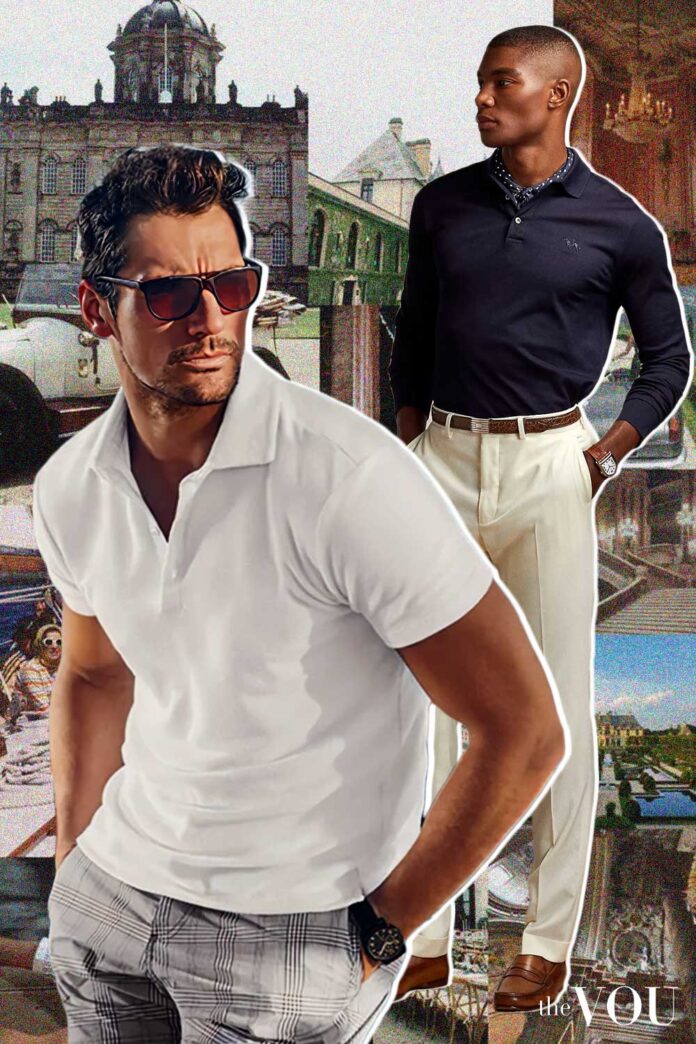Polo shirts are one of the most versatile garments any stylish man can own.
Great as semi-formal sporting attire and leisurewear, polo shirts match well with classic wardrobe pieces such as chinos, Bermuda shorts, boat shoes, seersucker, and Madras.
As a man, you can wear polo shirts everywhere, from football games to the office, and as part of many outfits, ranging from a tailored blazer to ripped denim jeans.
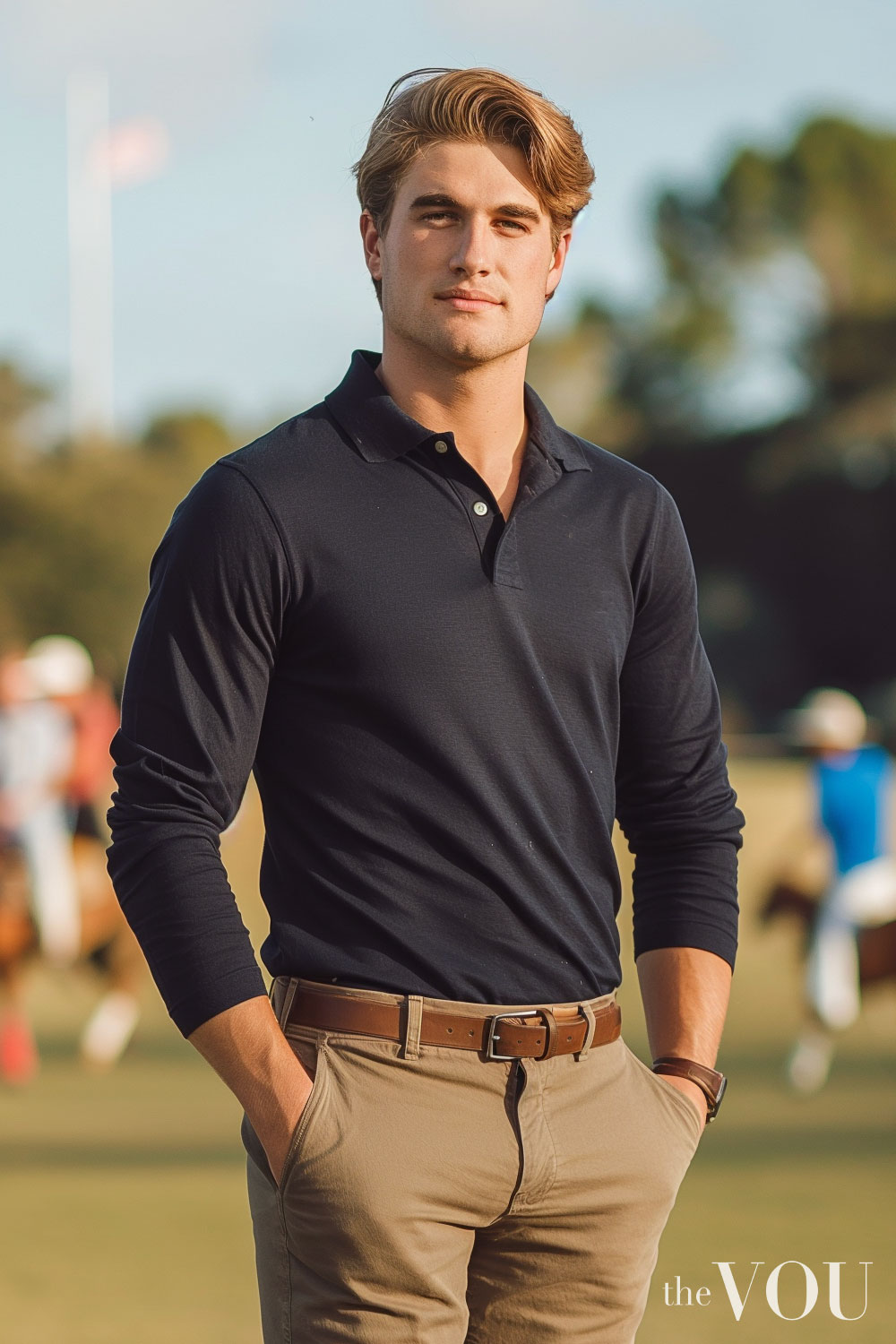
Even the oft-tuxedoed James Bond looks great in his Sunspel polo shirt, Bermuda shorts, Tod’s Gommino shoes, and Omega Seamaster.
However, while polo shirts can be wardrobe staples, knowing how to choose the right material, cut, colour, and combinations and take advantage of all the style possibilities this unique shirt presents is an art.
So, if you want to know how to wear Polo shirts as a leisure garment or use them as sportswear on golf courses or tennis courts, this guide is for you.
Polo Shirt – What is it?
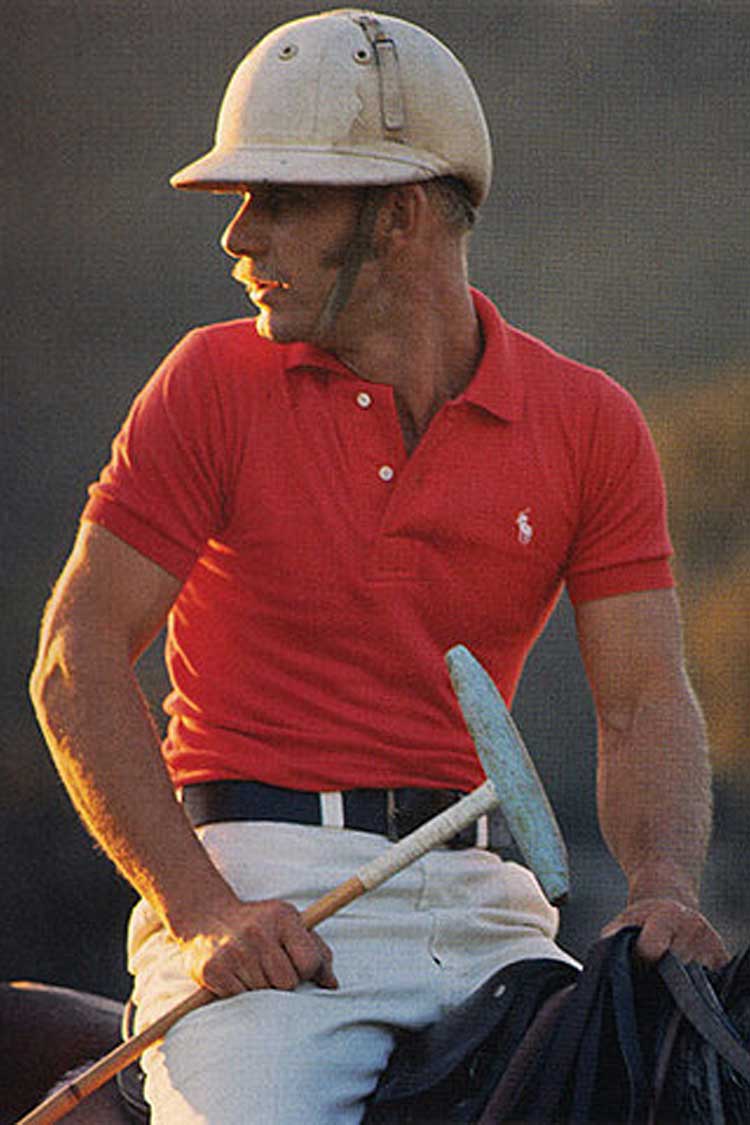
The Polo shirt is one of menswear’s most popular casual shirt styles and a core garment in Old Money styles such as Preppy, Sloane Ranger, and BCBG.
With origins on the polo fields, few other shirts are seen on middle managers and suburban dads as often as glimpsed on celebrities and music stars.
Semi-Formal Events – The polo shirt can be worn on almost every occasion when an open collar is substituted for a dress shirt and tie.
The shirt’s versatility allows it to be paired with several types of trousers, from jeans and chinos to dress pants.
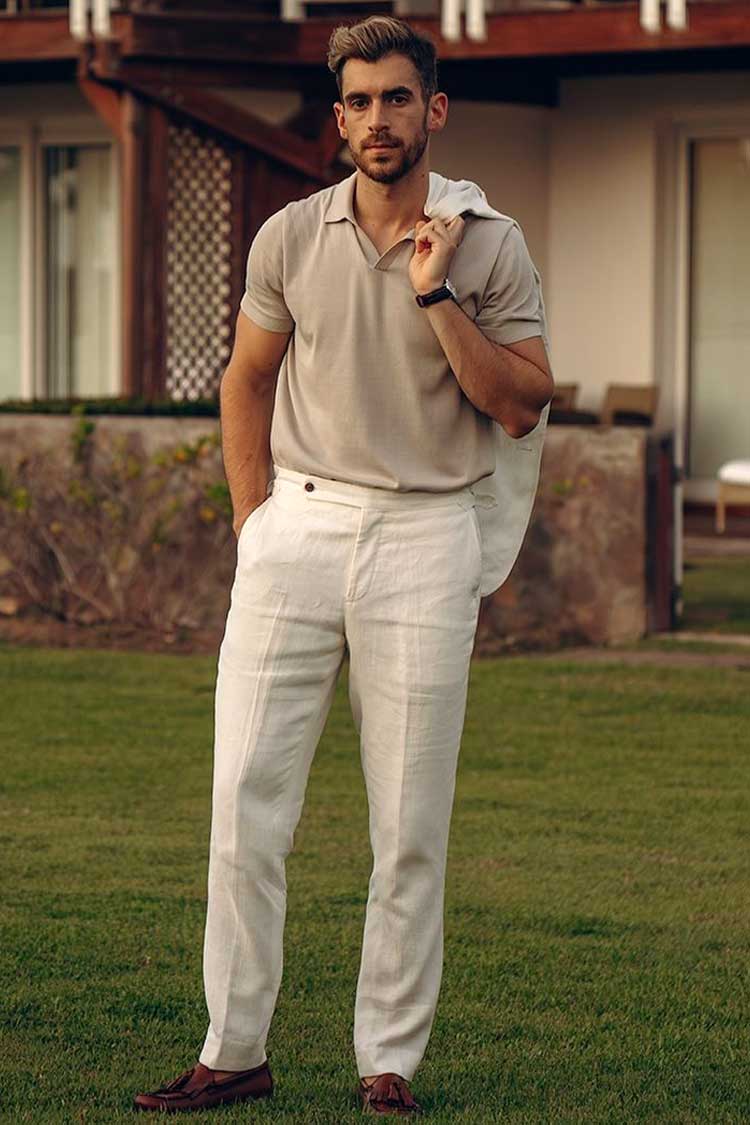
Sports Events – Lightweight and breathable but retaining a certain well-put-together air, the polo shirt remains true to its roots as a favoured garment for tennis players, golfers, and many other athletes.
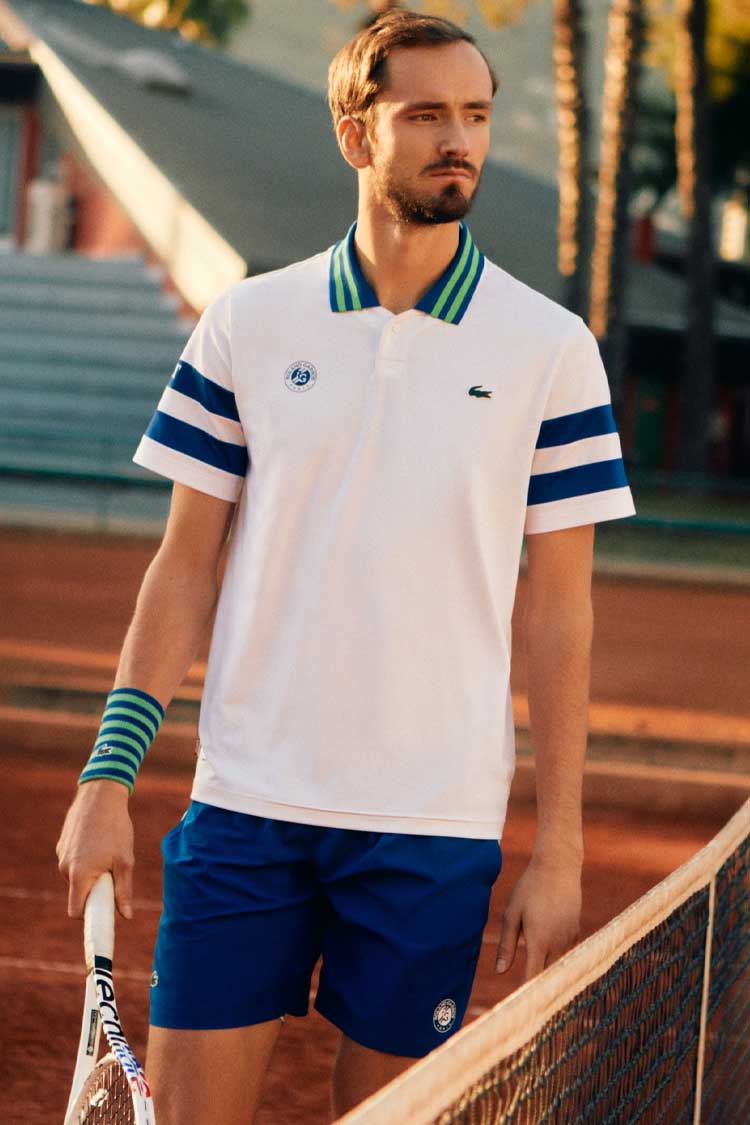
Preppy and Collegiate Events – From the halls of Harvard and Yale to the fraternity keggers of the local state university, polo shirts are indelibly associated with contemporary collegiate style.
Whether paired with Bermuda shorts at a cookout or worn with the collar popped while playing beer pong, polo shirts are strongly associated with college culture.
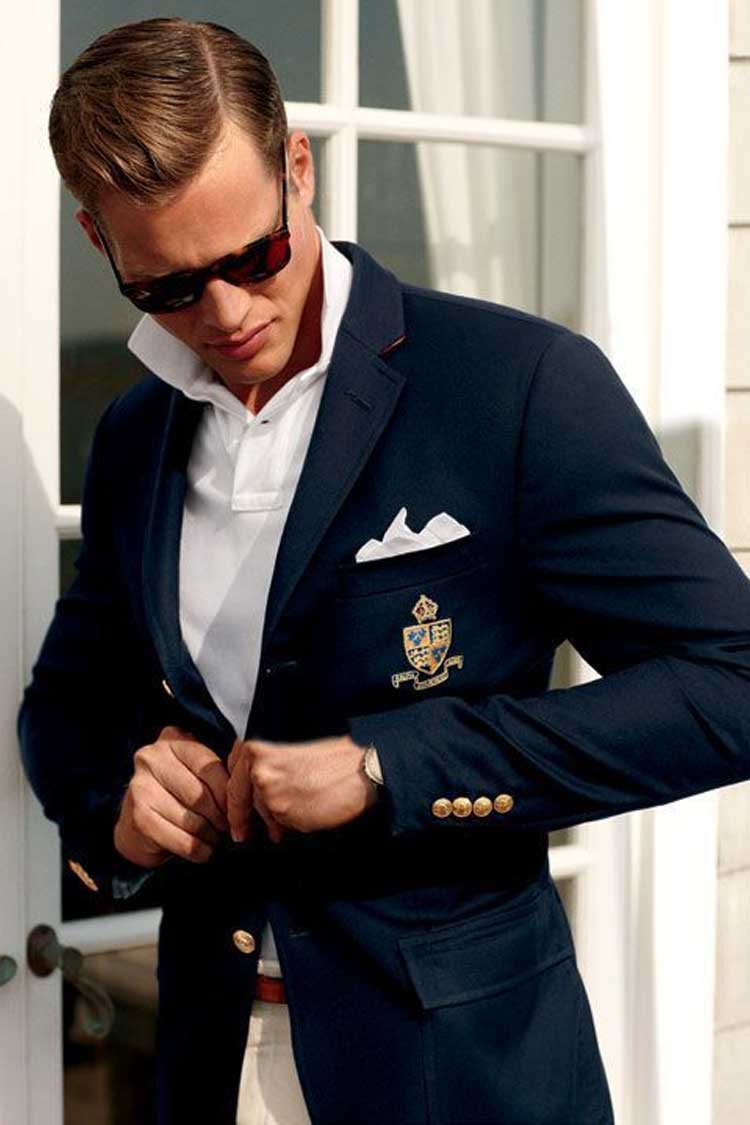
Business Casual – With the rise of the modern tech industry and more offices adopting less formal work environments, polo shirts became standard work apparel in these fields.
More industries noticed, and the polo shirt was included in many trade and retail uniforms, from blue-collar plumbers and exterminators to big-box retail stores.
Companies began to realise that they could easily brand the shirts and began to use them as staff uniforms, with logos imprinted on the sleeves, breasts, collar, and back.

Casual Events – Because of their casual and comfortable fit (white is still relatively formal), polo shirts are favoured on various occasions, from running errands to fun grilling and laid-back meals.
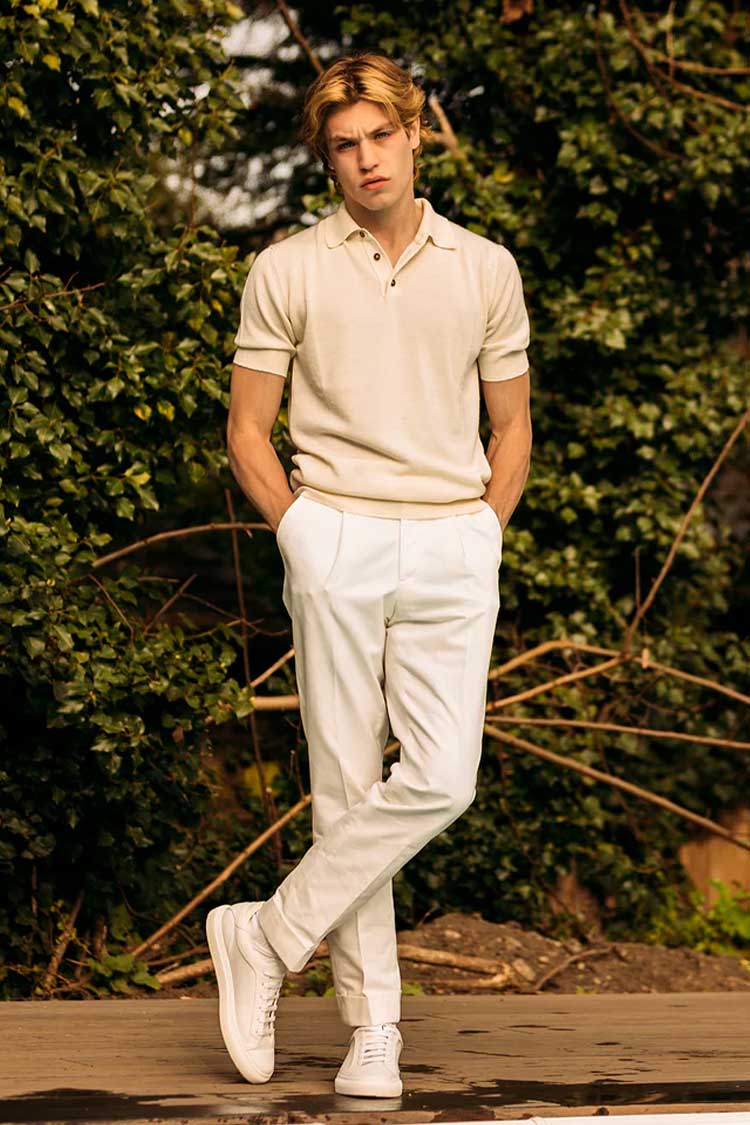
How to Choose Your Polo Shirt
Choosing the right polo shirt for a wealthy, old-money look requires knowing more than just the brand’s name; it also requires knowing the materials, weaving type, sleeve and collar type, etc.
Polo Shirt Fabrics
Most polo shirts are made from one of six common materials.
The best material depends on your desired price point and how you intend to employ the polo shirt in your capsule wardrobe.
Cotton – Cotton shirts are the most common polo shirt today. They are moisture-wicking, breathable, and decently durable.
Of course, not all cotton is alike, and cheaper cotton polos use short-staple cotton that will cause pilling and faded colours after a few washes.
Long-staple cotton will last longer and likely feel better on your skin; however, all cotton will also eventually fade in colour, especially darker colours.
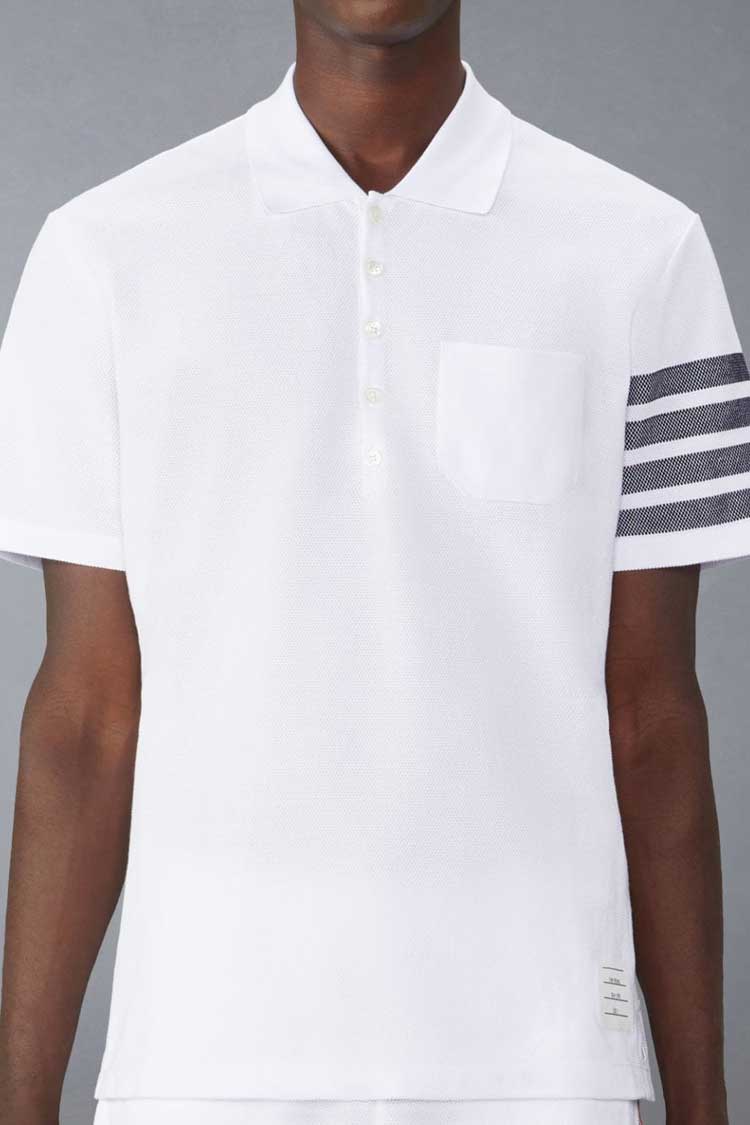
Silk – Light, comfortable, and shiny, silk is a favourite material for high-end and luxury polo shirts.
However, pure silk can have several drawbacks when used for polo shirts.
The most significant is that silk fades when moisture or high heat is exposed, frequently occurring in polo shirts.
To mitigate these issues, consider cotton-silk or linen-silk blends as alternatives.
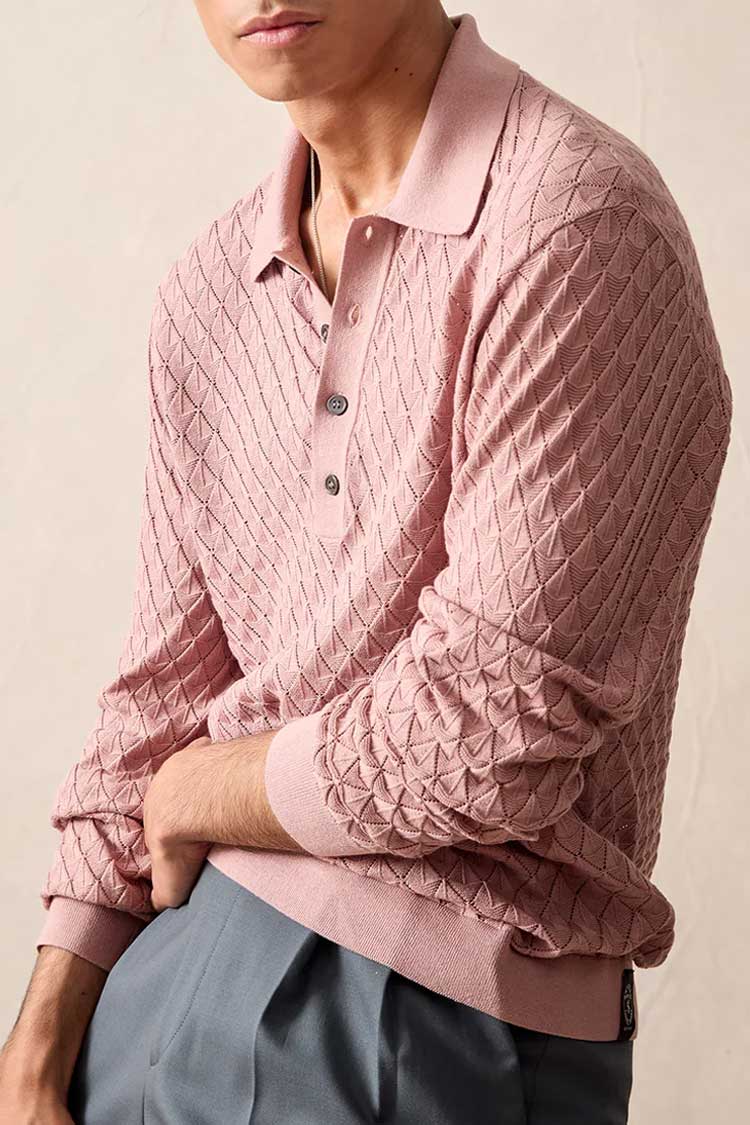
Linen – In recent years, linen has become more popular for knitwear, and some makers now offer linen polo shirts.
Its crisp look and sophisticated wrinkles add another dimension to this casual garment, which has great visual interest. However, it is also much rougher than cotton.
As such, it is only recommended in blends to achieve that wavy linen look without sacrificing comfort.
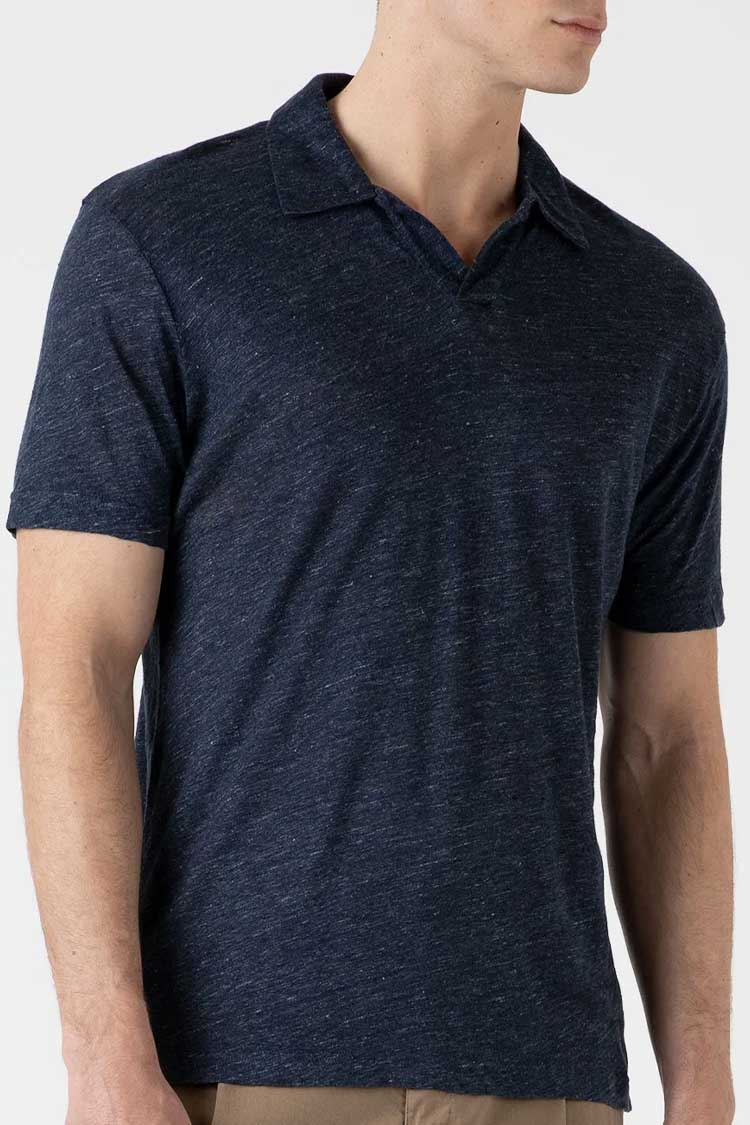
Performance – Performance polos are made with athletes in mind and have unique features, such as silver particles to reduce odour, built-in ultraviolet light protection, or ceramic to reduce heat.
These shirts are intended only to be worn on athletic fields or when exercising, not anywhere else.
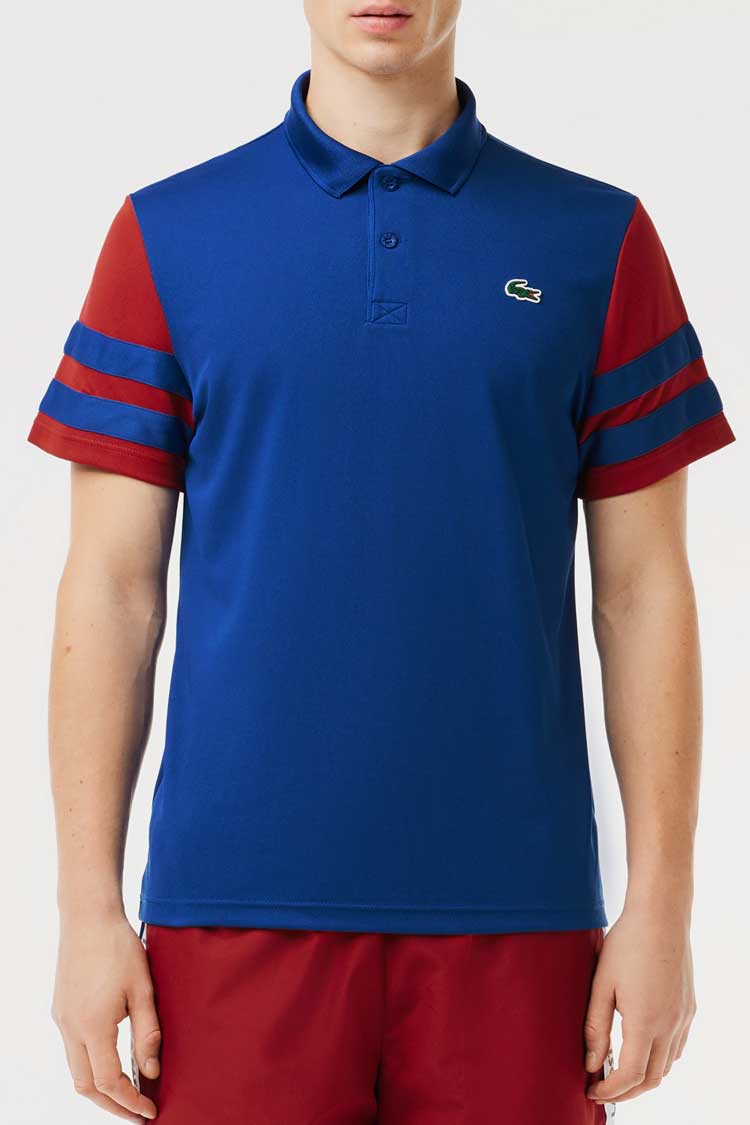
Synthetics – While polo shirts made from synthetic materials like polyester have a few benefits, such as resistance to wrinkling, shrinking, and staining, they have drawbacks, such as breathability, unappealing textures, and a cheap appearance.
As such, avoid shirts made from these materials if at all possible.
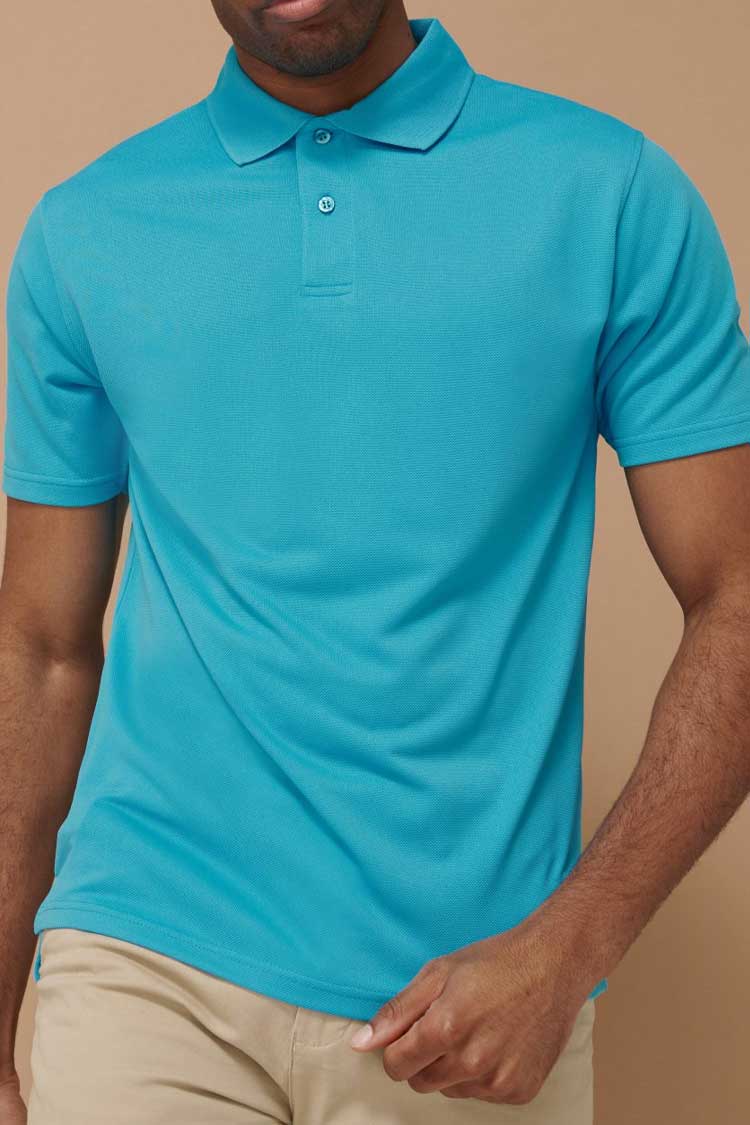
Blended – Blended fabrics are used for corporate polo shirts or grocery store uniforms because the blended synthetics increase durability and stain resistance at a low price point.
At the same time, they are less comfortable than all cotton materials, and they sometimes make the wearer more prone to sweating.
These are the most commonly found polo shirts on the market, right in the middle to low end when it comes to price.
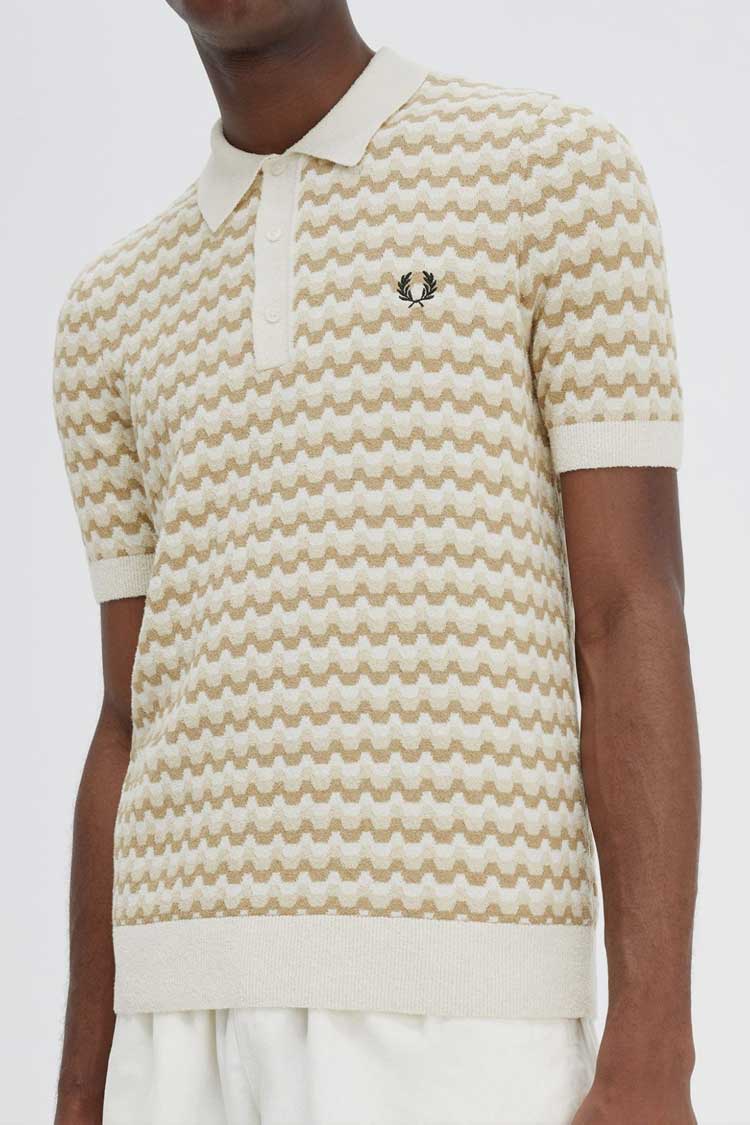
Knit and Weave
How the polo shirt’s material fibre is assembled will considerably impact quality.
In conventional weaving, two sets of yarn or thread are interlaced at right angles to form the fabric.
However, most polo shirts are not woven; they are knitted, in which yarns are interlaced.
Polo shirts are commonly knit in one of two ways. Ultimately, which knit is right depends on how you want your polo to look and function.
Pique Knit – Pique knit is known for its iconic three-dimensional waffled appearance.
The name comes from its resemblance to marcella pique, a fabric reserved for evening garments for formal events.
Pique knit is known for being both flexible and breathable, with breathability increasing relative to how large the knit is.
The majority of knit polo shirts employ a pique knit.
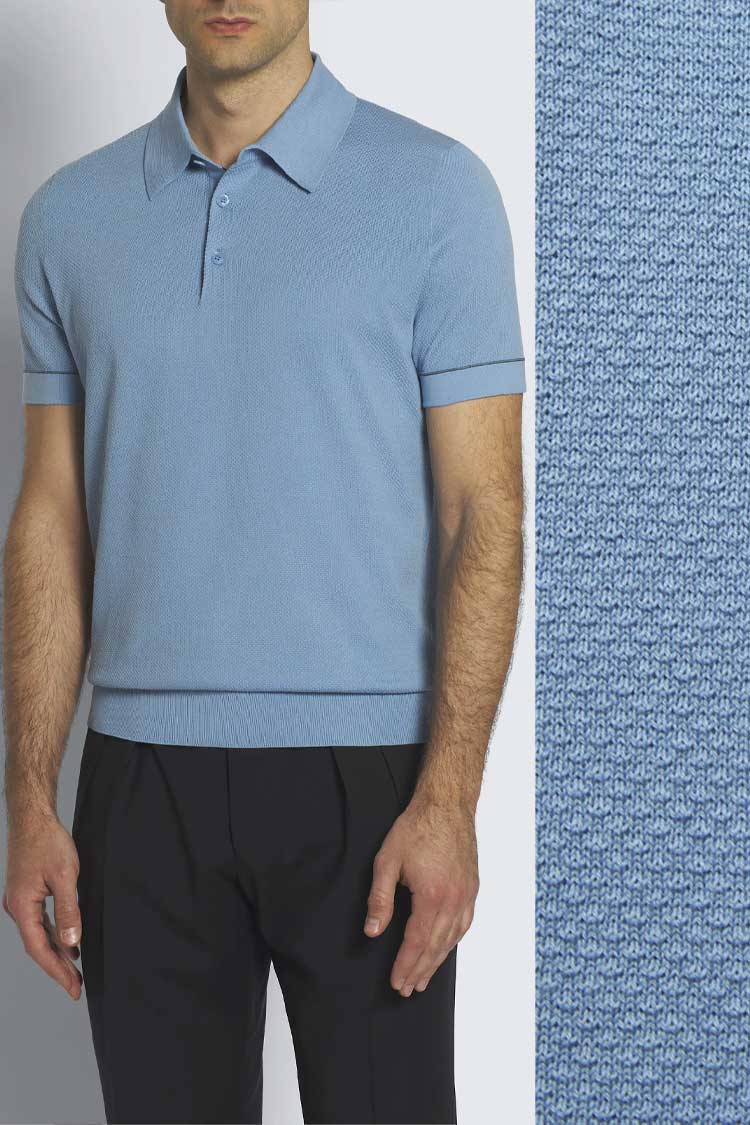
Jersey Knit – Jersey knit is the second most common knit for polo shirts.
Because of the tighter interloping of its yarns, Jersey knit has a smoother texture and often a more lustrous appearance.
This tightness also means, however, that it is not as breathable as pique knit.
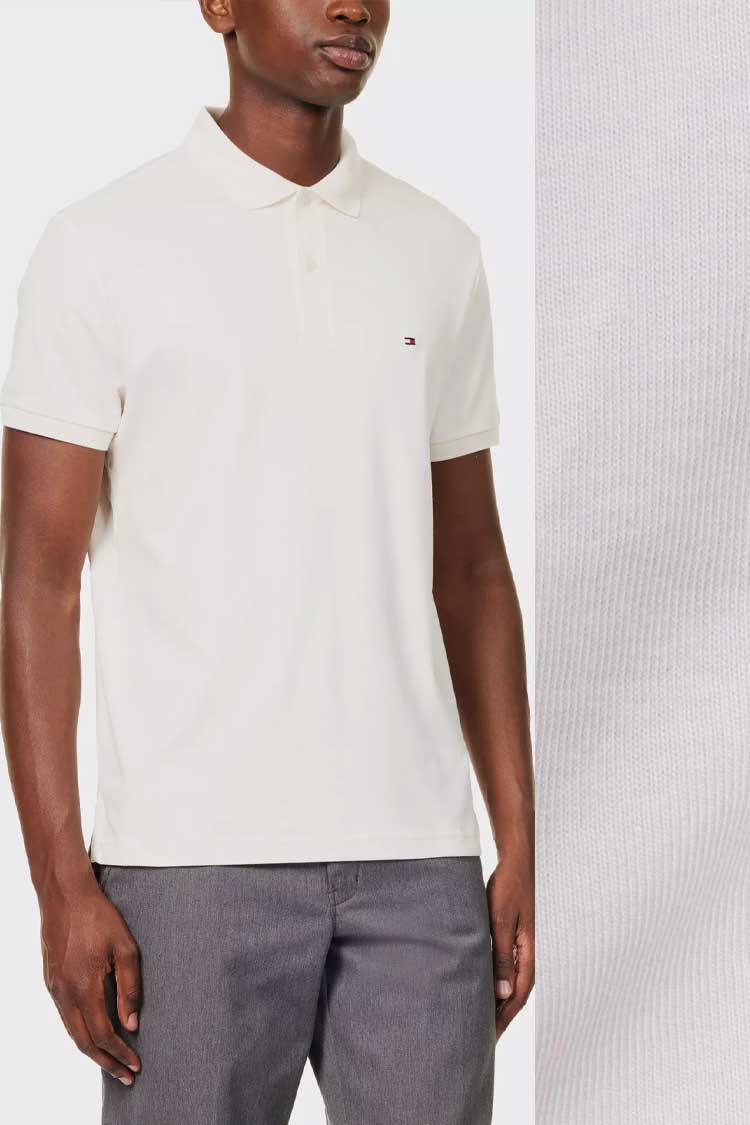
Sleeve Construction
Sleeve construction refers to how the sleeves of a polo shirt are attached to the garment’s trunk.
Two types of polo shirt sleeves are the most common:
Set-In Sleeve – The head of the sleeve is attached flush with the trunk of the shirt.
A seam at the shoulder circles around the arm hole and holds the sleeve in place.
Raglan Sleeve – The sleeve head extends in one piece over the shoulder to the collar with an extended diagonal sleeve.
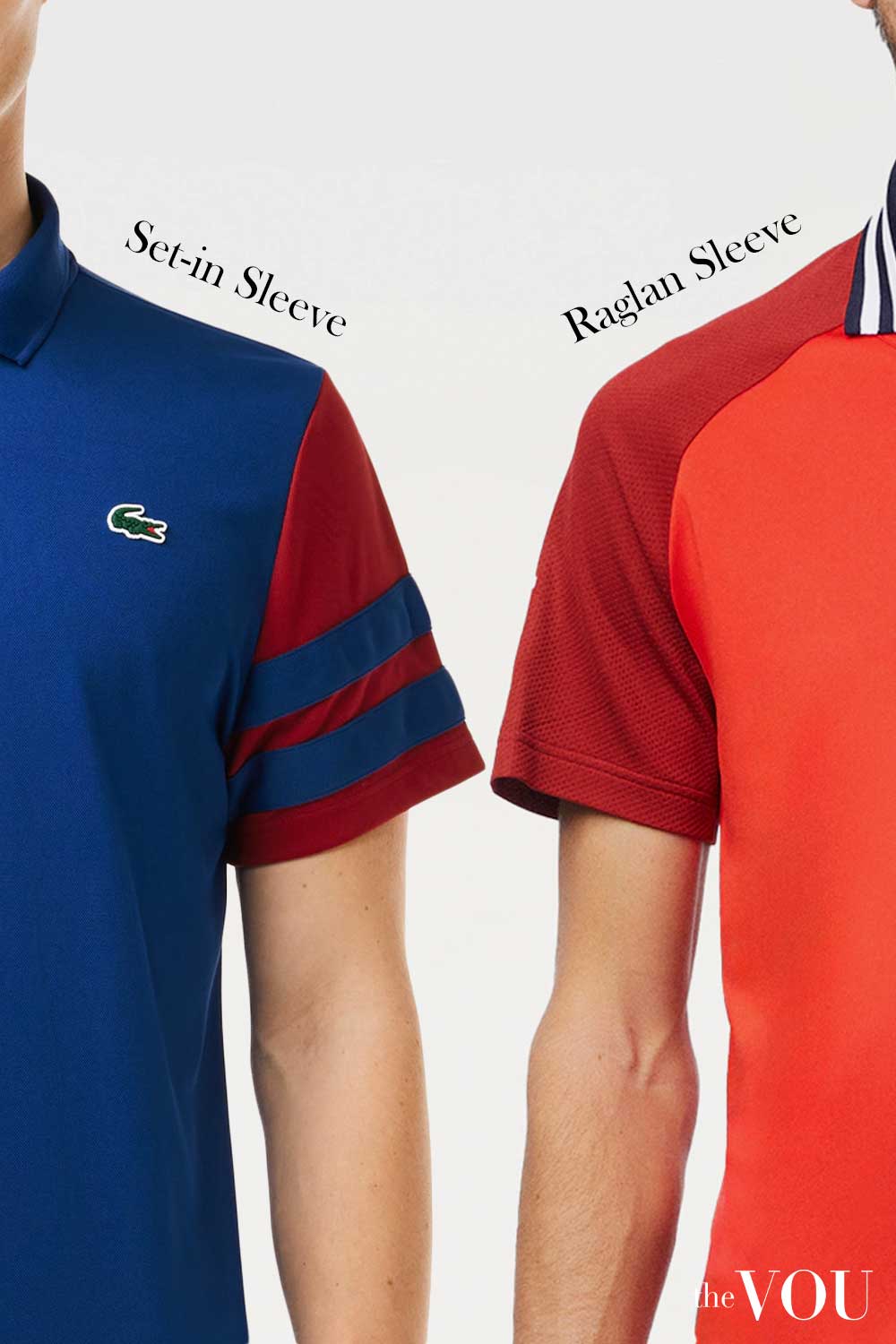
Because this sleeve type puts less stress on the shoulder joint, it offers greater comfort and a greater range of movement.
It will, therefore, be more commonly employed for higher-end polo shirts.
Sleeve Cuff
Polo shirt sleeve cuffs can be finished in two basic ways.
Basic Hems – A basic hem consists of a simple, finished termination that drapes loosely at the cuff.
This sleeve cuff can seem visually unappealing and baggy, but it is very comfortable as no fabric constricts the arm.
Ruched Hems – Ruched hems sit more tightly around the arm and tend to have a more trim and neat appearance.
Either welted or ribbed because of different stitch densities, welt cuffs tend to be slightly more elastic than ribbed cuffs, but they are otherwise very similar.
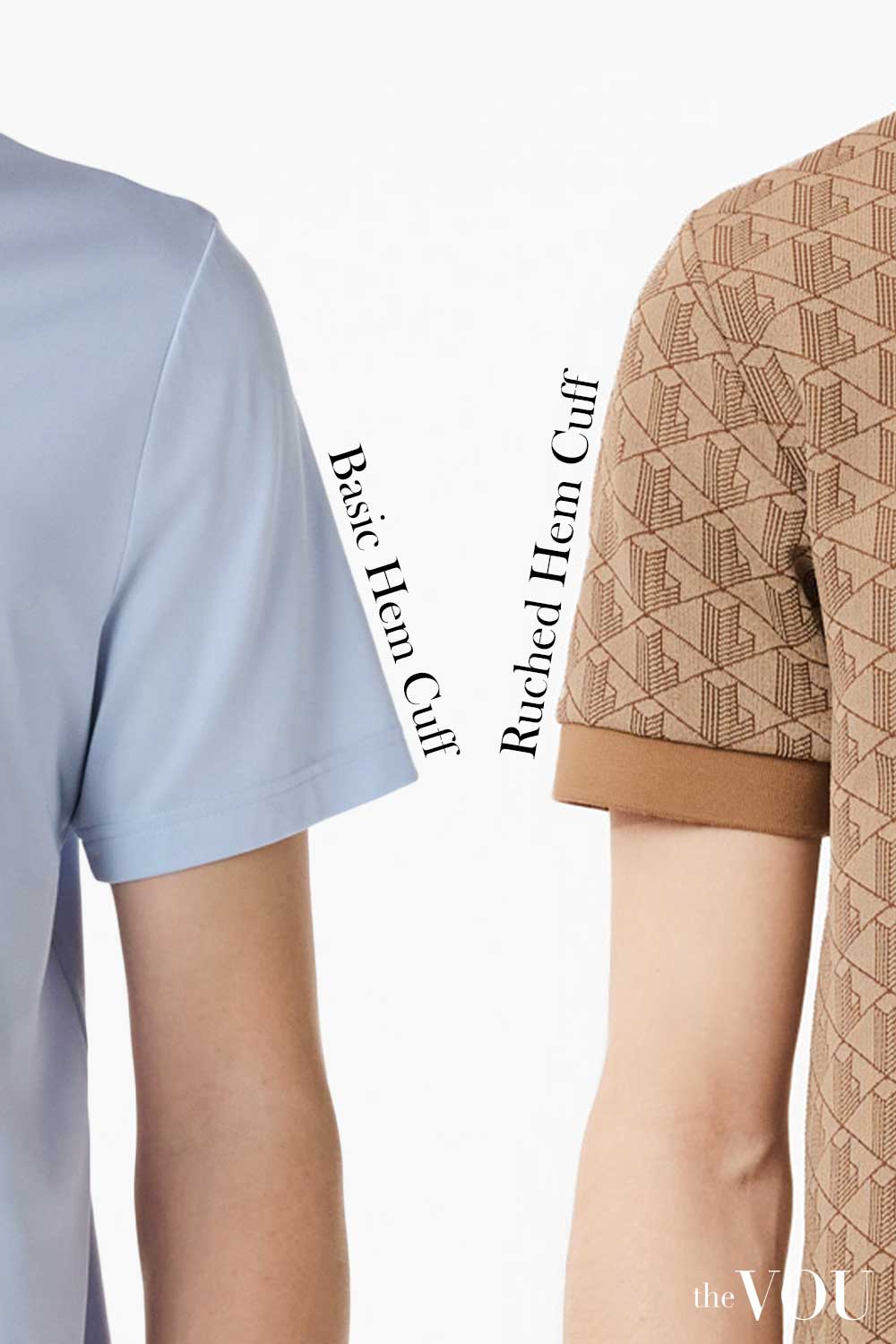
Collar Construction
Almost all polo shirts have a soft, ribbed collar set broadly to encourage good airflow.
Unfortunately, these soft collars are often flimsy and tend to wrinkle or curl at the edges.
Some companies offer collar stays that you can glue onto your polo shirts to fix this problem, but we have found that they don’t work very well.
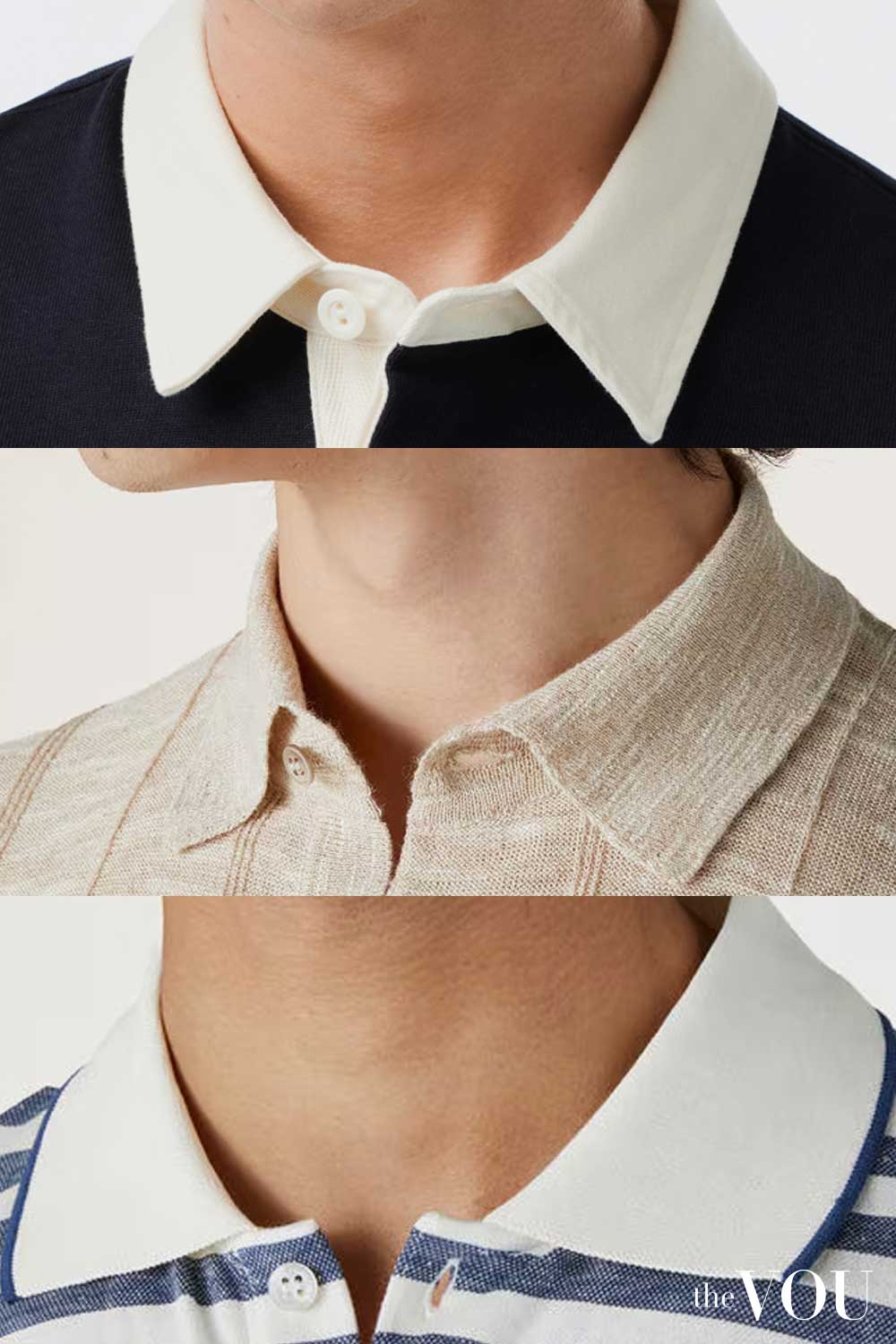
If possible, opt for a polo shirt with an interlining similar to a genuine shirt collar.
These collars will appear neater and trimmer, and you can also select different collar types for expanded styling options.
Placket
The placket of the polo shirt sits right at the collar, and how it is assembled considerably impacts quality.
Three placket types are commonly employed for polo shirts.
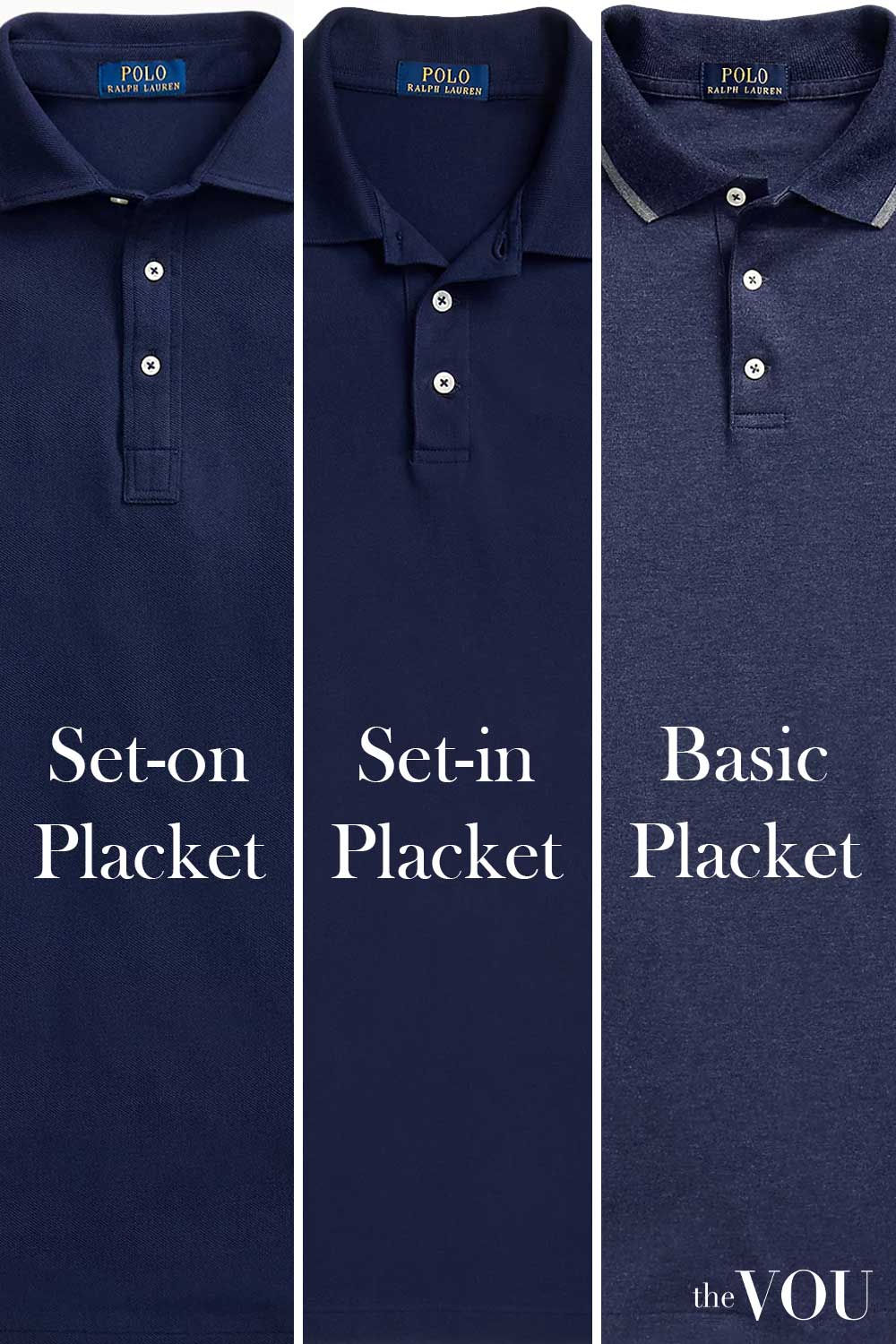
Basic Placket – A Basic Placket (also known as shirt plackets or Solly plackets) is a simple, standard placket found on most shirts.
It is created by folding the fabric over twice, creating a clean and reinforced opening for buttons and buttonholes.
Makers favour this style because it requires less fabric and stitching, as the cuffs are made from the shirt’s body; as such they are found on more inexpensive polo shirts.
Set-In Placket – Set-in plackets are very similar to the basic placket but use more stitching on the button-hole side of the placket, giving them a tailored appearance.
they are constructed by inserting a separate piece of fabric into the garment opening. This type of placket is sewn directly into a cut opening and is often used on sleeves or pant fly openings.
Set-On Placket – Set-On attached plackets require considerably more stitching and fabric because the placket is sewn separately from the shirt and attached afterwards.
Because of its interfacing, this option offers a more rectangular and clean appearance and is usually found on expensive polo shirts.
Plackets can be hidden by adding an extra layer of fabric that lies over the placket.
This hidden placket creates a cleaner overall appearance and often appears on higher-end polo shirts.
Button Arrangements
Polos can have anywhere from 1 to 6 buttons, although 2 or 3 is the most classic.
Buttons can be made from any material, with plastic being the most common and mother-of-pearl or horn being the most classic.
Buttonholes are a great way to assess the quality of the construction of a polo shirt.
Poorly made buttonholes are sewn and then cut, leaving them with a distorted appearance and lots of loose threads.
While you should not expect most polo shirts to have hand-sewn buttonholes, quality machine-sewn buttonholes should remain tidy with no loose threads.
Pockets
While some polo shirts feature a breast pocket, we suggest skipping it unless you plan to carry something, like your sunglasses.
An extra pocket can spoil the shirt’s lines, which often become saggy and wrinkly with age.
How to Style a Polo Shirt
Now that you know how to find the best polo shirt, we will share tips and tricks for achieving the best possible look in your polo.
The Correct Fit
As with most things in menswear, fit is king, even with casual shirts like polo shirts.
The most Classic fit for a polo shirt will be comfortably fitted with a torso that gently implies an inverted V silhouette without squeezing your midsection.
A super-tight slim fit might be trending now, but unless you have a muscular figure, it will not look good on most body types and isn’t typical of Classical Style.
Polo shirts should ideally fit in the shoulder like a dress shirt, but it can be difficult to get a perfect fit in the shoulders because they are mass-produced in more limited sizes.
Experiment with various polo shirt makers to identify brands with proportions that align well with your own.
Today, many manufacturers offer different kinds of fits, and while they are not absolute indicators, they will tell you how the shirts fit relative to other polo shirts of the same brands.
Classic Fit – Ideal for men who don’t have washboard abs and chiselled pecs, the classic fit has lower armholes with sleeves that reach closer to the elbow.
They offer a very relaxed drape over the torso, and their longer back hem allows them to be tucked into pants or shorts.
This is great if you have some love handles you’d like to hide or if you prefer to tuck your shirts in.
Slim Fit – Perfect for the guy in great shape and athletic use, these polo shirts have the trimmest fit throughout the torso and sleeves, with a shorter back and front hem that allows the shirt to be untucked.
Custom Fit – The custom fit is between classic and slim-fit polo shirts – with higher armholes than the classic fit and a shorter sleeve length.
It also features a trimmer fit against the torso, with a slightly shorter front and back hem than the classic but longer than the slim fit.
Sleeve Length
The sleeves of a polo shirt should fall about halfway to two-thirds of the way between your shoulder and elbow.
You can go somewhat shorter if you prefer a more vintage look or longer for a more contemporary look.
Regardless of length, the sleeve cuffs should sit securely without appearing loose, dangling, or overly tight and constricting.
‘The Finger Test’ is an easy way to determine if your polo shirt fits well in the sleeves.
If you can easily slide your finger between the sleeve and your skin, but the fabric still contracts against your skin on the opposite side, you are on the right track.
Hem Length
The desired hem length of a polo shirt will vary depending on whether or not you intend to wear the shirt tucked or untucked.
In an innovation dating back to Rene Lacoste, classic polo shirts have a “Tennis Tail” that makes it longer in the back than the front.
This added length was intended to allow for greater movement while keeping the shirt neatly tucked in.
If your polo shirt has a Tennis Tail, you should plan to wear it tucked in.
For polo shirts without Tennis Tails, the bottom hem should sit just below your belt line if you plan to wear it untucked or no more than halfway past your buttocks or fly front if you plan to wear them tucked in.
Old-Money Colours
When it comes to colour selection for the old money aesthetic, the most versatile variety of colours will be those commonly found in Classic menswear, such as white, grey, navy, blue, green, and neutrals.
Because polos are so closely associated with warm weather, they also look great in various spring and summer colours, such as yellow, pink, orange, and similar pastels.
Ultimately, your polo colour selection should fit your style, but because polos are typical of a more casual look, don’t be afraid to have fun and experiment with bolder colours.
Traditional Patterns
Polo shirts are available in all patterns typical of Classic Menswear, and contemporary iterations may also feature graphic designs.
For the most traditional look, classic patterns are the safest choice.
Overly involved, oversized, or dramatic graphic images may cause the polo shirt to resemble a tee shirt, precipitously making it appear more casual.
Polo Shirt Etiquette
Do’s
Wear fitted polo shirts but not tight – If you can’t stick a finger between your bicep and sleeve, get a bigger size.
If there’s a lot of slack, get a smaller size that drapes nicely over your body without showing too much of your body.
Size polos to your height – Unless you prefer a tunic-like fit, ensure the tail of an untucked polo shirt doesn’t extend further than midway down your buttocks.
Not only will it crumple and show when tucked in, but if left untucked, it will also throw off your proportions.
Also, avoid tennis tails with a longer back hem if you plan to wear your polo shirt untucked.
Tuck in your polo (when the situation calls for it) – It would be wrong to stipulate that you should never tuck or untuck your polo shirt. Rather, it depends on the outfit and the occasion.
With a pair of Bermudas or Madras shorts, you don’t want to tuck your polo shorts in, but with Seersucker slacks or chinos, it looks better when tucked in.
Experiment with fun colours and patterns – As casual shirts for warm and hot weather, polo shirts offer considerable leeway for bold and vibrant patterns.
Do not be afraid to take advantage of this opportunity to add unexpected colours, patterns, and textures to your ensemble.
This will generate visual interest and help distinguish you from other men wearing boring polos.
Don’ts
Never layer polo shirts – A properly fitted polo shirt should skim but not hug your frame, so there shouldn’t be room for another shirt.
Wearing an undershirt almost guarantees it will slip from under your sleeve or crumple at the collar.
Polo shirts aren’t made for layering, and we suggest you not wear an undershirt, long or short-sleeved, with a polo shirt.
Accordingly, don’t layer more than one polo shirt at a time; this inexplicable trend is a cry for attention rather than a real fashion statement.
Don’t wear oversized logos – The trend of large oversized logos on polo shirts started with Ralph Lauren’s creations for the Asian and Russian markets and has progressed to other brands.
Regardless of your country of origin, as a gentleman trying to look successful and wealthy, you should never wear visible logos.
However, with polo shirts, having a small logo on the breast is often unavoidable since it has become the standard.
Some companies offer tone-in-tone logos with the knit, which is preferable to contrasting logos.
In any case, oversized logos are nothing short of atrocious, so leave the logos to the kids unless you wear one as part of your work uniform.
Don’t wear polo shirts with blazers – Some men think they look smart sporting shirts with blazers, even though the soft collar isn’t flat.
No matter your situation, a blazer will always look better with a dress shirt, so skip the polo and go right to the dress shirt.
Here is how to correctly style a blazer.
A Touch of Sprezzatura
Some argue that popping your polo shirt’s collar is over, as a tasteless trend like wearing sunglasses at night.
However, on certain occasions and outfit combinations, a polo shirt with the collar up looks stylish, so don’t be afraid to experiment with a touch of sprezzatura from time to time.
Old-Money Polo Shirt Brands to Consider
There are several polo shirt manufacturers at different price points.
However, while the price might be a good indicator of value, what matters is the brand’s heritage and recognition.
Always wear authentic Old Money brands with a solid reputation with Preppy, Sloane, and BCBG crowds.
- Polo Ralph Lauren – $$$
- Thom Browne $$$
- Valentino $$$
- Saint Laurent $$$
- Criquet $$$
- Missoni $$$
- Orlebar Brown $$$
- Todd Snyder $$$
- Fred Perry – $$
- Lacoste – $$
- Izod $$
- Tommy Hilfiger $$
- Sunspel – $$$
- Brioni $$$$
- J. Crew $$
- Club Monaco $$
- Boast $$
- Jack Spade $$
- Southern Marsh $$
- Brooks Brothers $$
- Southern Tide $$
- Southern Proper $$
- Banana Republic $$
- Vineyard Vines $$
Athletic Polo Shirt Brands to Consider
One big difference between the standard polo shirts and the golf or tennis polos is the level of performance.
Athletic polo shirts are specifically engineered to allow the wearer a wider range of motion and to protect them by wicking moisture away from the body under the hot sun.
While amateur golf and tennis players wear polo shirts from Ralph Lauren, Lacoste, or Brooks Brothers, professional athletes stick with shirts made from a synthetic blend of materials designed for active living.
It is tough to say whether that’s due to brand sponsorship or its enhanced performance capability.
- Fred Perry – for Tennis – $$$
- UnderArmour – for Golf and Tennis – $$
- KSwiss – for Tennis – $$
- Aasics – for Golf and Tennis – $$
- Ralph Lauren – for Tennis – $$
- Lacoste – for Tennis – $$
- Footjoy – for Golf – $$
- Travis Mathew – for Golf and Tennis – $$
- PGA Tour – for Golf – $
- Nike Golf – for Golf – $
- Nike Tennis – for Tennis – $
- Callaway – for Golf – $
- Mizuno – for Golf – $
- Reebok – for Golf and Tennis – $
- Adidas – for Golf and Tennis – $
- Ashworth – for Golf – $
- Snakes Eyes – for Golf – $
- PING – for Golf – $
- Oakley – for Golf and Tennis – $
- Puma – for Golf – $
- New Balance – for Golf and Tennis – $
- Wilson – for Golf and Tennis – $
- Babolat – for Tennis – $
- Fila – for Tennis – $
Polo Shirt Origin
As the name implies, the history of the polo shirt is closely linked to the history of the game of polo.
However, the modern polo shirt we recognise today looks very different from its ancient antecedent.
Polo had been played in Asia for centuries, but it was introduced to Europeans during the expansion of the British Empire in the 17th and 18th centuries.
At the same time, Europeans were also introduced to the uniforms traditionally worn by locals when playing this game.
The English Bring the Polo Shirt to Europe
In Manipur, India, during the middle of the 19th century, British soldiers took up the Indian game and polo and adopted uniforms based on traditional examples.
These outfits usually consisted of long-sleeved shirts made of thick cotton with broad collars.
Because the broad collars on early polo shirts could flap in the breeze and were stuffy and uncomfortable when loose, buttons were added to help secure them and prevent them from flapping in the riders’ faces as their horses galloped.
By the early 1860s, polo uniforms were well-established in Great Britain and soon spread across the European Continent, eventually reaching North America.
Brooks Brothers’ Polo Collar
During a trip to England in 1896, John E. Brooks, heir to the American Brooks Brothers haberdasher, attended a polo game and noticed the polo players’ button-down collars on the shirts.
Thinking it was a brilliant idea, he introduced a new dress shirt with a button-down collar that we know today as the button-down dress shirt.
Even though the “polo shirt” has evolved to represent a different clothing item entirely, Brooks Brothers still markets some OCBD shirts as the “Original Polo” shirt.
Lewis Lacey’s First “Polo” Polo Shirt
While the polo pony logo is today closely associated with Ralph Lauren, a different maker had already employed this logo almost fifty years earlier.
Lewis Lacey was a clothing designer and polo player who introduced a newer, lighter-weight cotton fabric to the game.
To market his new shirt, available at his store in Buenos Aires, Argentina, he embroidered a picture of a polo player on its breast.
Rene Lacoste’s Modern Polo Shirt
Rene Lacoste was a French tennis player and one of the biggest sports names in the 1920s and 30s.
Realising that the traditional polo shirt could have multiple uses, due primarily to its wind-resistant collar, he used it as a starting point to design a shirt that would eventually become the modern polo shirt.
Early 20th-century tennis shirts were often long-sleeved, had a full complement of buttons, and could be relatively heavy.
Based on the original polo shirt, Lacoste’s innovations called for removing the sleeves, which he had often worn roll-up on his traditional tennis shirt.
Lacoste also ditched the buttons traditionally found on tennis shirts, opting for a pull-over design. He also gave the shirt a longer hem in the back than in the front, allowing it to remain tucked in without restricting his ability to move and flex.
To this day, the asymmetrical shirt hem is still referred to as a “Tennis Tail.”
Reny Lacoste’s Cotton Pique
Lacoste adopted an innovative knit called pique cotton as a fabric for his new polo shirt.
Cotton pique could be machine-knitted, making it relatively easy to manufacture. It was also very light and breathable while retaining durability.
While Lacoste did not invent cotton pique, he was instrumental in popularising it as a sporting and leisure fabric.
Lacoste proudly wore his new shirt in the 1926 US Open, which he dominated, and immediately, the shirt became a staple in tennis wear and activewear worldwide.
Even the polo world noticed and adopted the same shirts for use in their game.
The button-down collar was no longer, and polo players liked Lacoste’s shirts because the comfortable yet sturdy collar could be popped up, allowing them more protection from sunburns.
Despite some confusion over the issue, the reptile on the Lacoste logo is decidedly a crocodile because “Le Crocodile” was Lacoste’s nickname.
However, the origins of this nickname are disputed; one theory claims that Lacoste’s large nose resembled the snout of a crocodile.
Another idea was that the force of his slams was like the snapping of a crocodile’s jaw.
Finally, Lacoste’s son, Bernard, claimed that the nickname originated from a bet involving, even more confusingly, an alligator-skin bag.
Paying homage to where Lacoste got the idea, he opted to call his creation a polo shirt rather than a tennis shirt.
In 1933, he formed a company to market his polo shirts, and the Lacoste brand was born. Focusing on polo shirt sales, their original market consisted almost exclusively of athletes and sports fans.
Realising he could sell more shirts if he created various designs, Lacoste and his designers created many colourful patterns, including stripes and graphics, presaging the modern trend of boldly styled polo shirts.
“They had spent a year in France for no particular reason, and then drifted here and there unrestfully wherever people played polo and were rich together.”
F. Scott Fitzgerald – American novelist and essayist.
Originally, polo shirts were almost the exclusive domain of the sporting world, including an introduction to the world of golf when American President Dwight Eisenhower wore a Lacoste polo while on the links.
Golf and country clubs soon adjusted their rules to allow for polo shirts on their courses, and almost overnight, the polo shirt became the preferred golf attire for golfers in North America and globally.
Polo Shirts in the Mid-20th Century
After World War II, the growing casualisation of menswear saw the introduction of an increasingly wide range of leisure and sports shirts.
The polo shirt, already popular in the world of sport, transitioned relatively easily into the world of casual men’s fashion.
Polo shirts became regular wear for men at informal social events like cookouts or when running errands.
Young men, in particular, flocked to the polo shirt, which slowly began to develop cachet as a status symbol and emblem of the youthful Prep Style.
Fred Perry’s Stitched Logo
Like Rene Lacoste, Fred Perry was a tennis legend who expanded into the fashion world.
Perry marketed his polo shirt brand that closely resembled Lacoste’s but with a logo that was stitched rather than ironed on.
While the Lacoste polo remained the preferred choice for athletes, fashion-conscious young men in the 1950s seemed to prefer Fred Perry’s offering because of its iconic emblem, one of the earliest examples of the adoption of logos in menswear.
By this time, it was clear that the polo was no longer just a sports shirt but a fashionable shirt to wear outside of athletics.
Ralph Lauren Enters the Polo Market
As the 20th century progressed, the polo shirt became a premiere shirt within casual menswear.
The polo shirt was so iconic that when Ralph Lauren was developing ideas for what to call his new line of casualwear clothing.
Eventually, he settled on the name Polo because it was evocative of the sport, with its royal association, sophisticated air, and whimsical fun and lightness of the polo shirt.
The polo player emblem of the Polo Line first appeared on women’s suits in 1971.
A year later, Ralph Lauren launched a polo shirt featuring the famous design as the flagship offering of his new line of casual menswear items.
The Polo Wars
By the opening of the 1980s, one of the first decades in which brand consciousness was a significant consideration in men’s fashion, several clothing retailers had well-established lines of polo shirts, including Izod, Fred Perry, and Brooks Brothers, to name a few.
These brands competed fiercely to establish their superiority and dominate the lucrative polo shirt market. Within a few years, it was clear that Lacoste and Ralph Lauren were the primary contenders for the crown.
Thanks to its deeper corporate pockets and popularity with the Ivy League set, the Ralph Lauren polo emerged as the winner, becoming the iconic polo coveted by men worldwide.
Polo Shirt FAQ
What Was the Original Polo Shirt?
The first “polo” shirts were heavy cotton shirts British polo players wore, but in the 20s, the French tennis player Rene Lacoste developed a new shirt modelled after the shirts of the polo players and called it the polo shirt.
Although designed for use in tennis, this polo shirt is what we today know as a polo shirt.
Which Brand Makes the Best Polo Shirts?
Ultimately, the best brand and price point for a polo shirt depends on what you need the polo shirt to do.
Still, you can expect to pay more for polos that have more attentive, constructive, and expensive materials and for polo shirts made by luxury brands.
How Many Polo Shirts Should a Man Own?
How many polo shirts you should own depends on your preference, but in general, having a few polo shirts in classic colours and styles will always be a good addition to your selection of classic casual shirts.
What Polo Shirt Colours Are the Best?
Classic menswear colours like white, grey, navy, blue, and green are versatile. Because polo shirts are more casual and are often worn in warmer temperatures, you can also consider bolder pastel options like yellow, orange, and pink.
What is the Best Material for a Polo Shirt?
Most polo shirts are made from cotton, but other quality natural fibres like wool, linen, and silk can also be good options, depending on your needs.
In general, synthetic fibres should be avoided unless you wear the polo for sports and prefer performance fabrics.
What is a Pique Polo Shirt?
Pique refers to the knitted pattern of the polo shirt fabric. It has a distinctive waffle-like pattern with superior breathability and flexibility.
How Should a Polo Shirt Fit?
In a Classic Fit, a polo should drape pleasingly at the shoulders with a lightly structured midsection that encourages a pleasing, but not sharp, inverted v, torso.
The sleeves should fall between the shoulders and elbow and be secure but not tight.
Are Polo Shirts a Trend?
While trends are associated with polo shirts, such as layering or popping collars, polo shirts have existed for over a century and have been staples in Classic menswear since the 1950s.
Opting for a polo shirt in classic colours with versatile styling will ensure that your polos are timeless and will look great on you for years.
Should I Tuck in my Polo Shirt?
If your polo shirt has a Tennis Tail, which is longer in the back than in the front, you should tuck it in.
You should also tuck your polo shirt in if it falls around the middle of your buttocks in length.
If you want to wear your polo shirt untucked, the hem should fall below your belt line.
Is a Polo Shirt a Formalm Garment?
While polo shirts have collars, they are inherently casual and should not be worn with any dress code above Business Casual.
Should I Wear Polo Shirts with Long or Short Sleeves?
The original polo shirts were long-sleeved, but since the 1930s, most contemporary polo shirts have had short sleeves.
Rugby shirts are the preferred long-sleeved sports shirt in Classic Menswear.
In recent decades, however, long-sleeved polo shirts have enjoyed a resurgence, with the Friday Polo by Luca Avitabile representing a prime example.
How do You Clean a Polo Shirt?
Always follow the individual washing instructions printed inside your polo.
However, cotton polos tend to shrink, so they should be washed gently in cool water and never put in a dryer. Also, always wash your polo shirts inside and out to reduce colour fading.
Style Like a Pro with The VOU
Knowing the history, materials, and types of polo shirts is one thing; however, knowing how to choose polo shirts according to your colour pallet, body shape, and desired fashion style is a form of art you can also master.
You get that by ordering one of our styling packages for men; a complete Fashion Styling package identifies your ideal colour and the most suitable polo shirts for your body shape from heritage brands and teaches you how to wear them like a pro.
Imagine walking into a room and turning heads for all the right reasons, or picture yourself radiating self-assuredness and sophistication, knowing you’ve nailed the polo shirt look for that particular occasion.
We’ve helped countless men like you elevate their style and achieve the much-coveted modern old-money style, so don’t hesitate to contact The VOU’s stylists right now for a free introductory class.
With over twenty years of front-row fashion and styling events, collabs with haute-couture houses, and a PhD in Luxury Fashion, Laurenti is an expert in crafting personalised looks that depict old-money sophistication.
With years of expertise in high-end fashion collabs and a PhD in Sustainable Fashion, Ru specialises in eco-luxe wardrobes for the modern gentleman seeking understated refinement.


